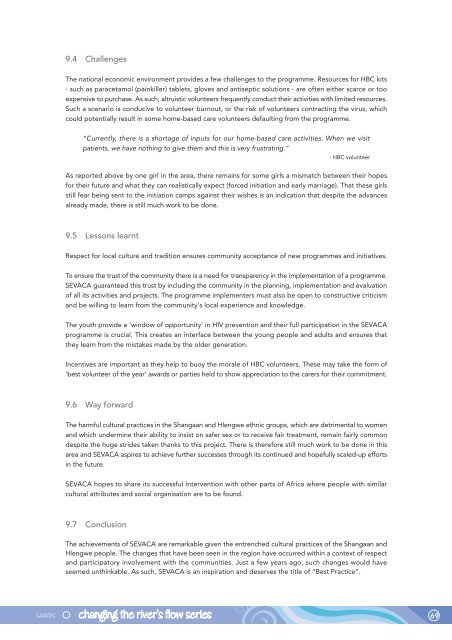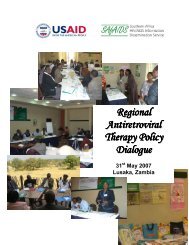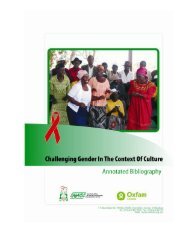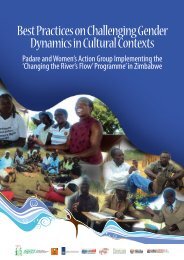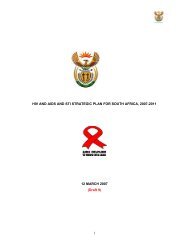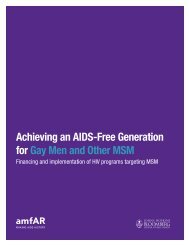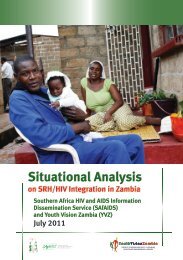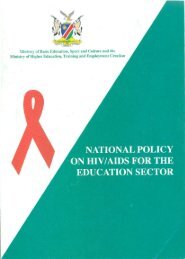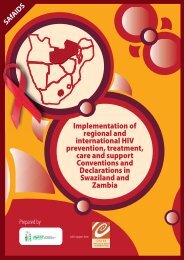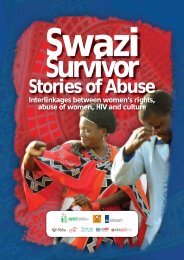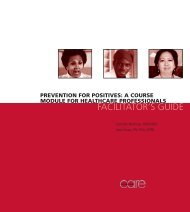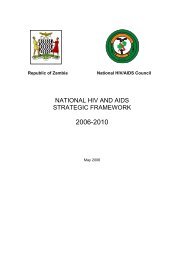Zimbabwean stories of "Best Practice" - SAfAIDS
Zimbabwean stories of "Best Practice" - SAfAIDS
Zimbabwean stories of "Best Practice" - SAfAIDS
You also want an ePaper? Increase the reach of your titles
YUMPU automatically turns print PDFs into web optimized ePapers that Google loves.
9.4 ChallengesThe national economic environment provides a few challenges to the programme. Resources for HBC kits- such as paracetamol (painkiller) tablets, gloves and antiseptic solutions - are <strong>of</strong>ten either scarce or tooexpensive to purchase. As such, altruistic volunteers frequently conduct their activities with limited resources.Such a scenario is conducive to volunteer burnout, or the risk <strong>of</strong> volunteers contracting the virus, whichcould potentially result in some home-based care volunteers defaulting from the programme.“Currently, there is a shortage <strong>of</strong> inputs for our home-based care activities. When we visitpatients, we have nothing to give them and this is very frustrating.”- HBC volunteerAs reported above by one girl in the area, there remains for some girls a mismatch between their hopesfor their future and what they can realistically expect (forced initiation and early marriage). That these girlsstill fear being sent to the initiation camps against their wishes is an indication that despite the advancesalready made, there is still much work to be done.9.5 Lessons learntRespect for local culture and tradition ensures community acceptance <strong>of</strong> new programmes and initiatives.To ensure the trust <strong>of</strong> the community there is a need for transparency in the implementation <strong>of</strong> a programme.SEVACA guaranteed this trust by including the community in the planning, implementation and evaluation<strong>of</strong> all its activities and projects. The programme implementers must also be open to constructive criticismand be willing to learn from the community's local experience and knowledge.The youth provide a 'window <strong>of</strong> opportunity' in HIV prevention and their full participation in the SEVACAprogramme is crucial. This creates an interface between the young people and adults and ensures thatthey learn from the mistakes made by the older generation.Incentives are important as they help to buoy the morale <strong>of</strong> HBC volunteers. These may take the form <strong>of</strong>'best volunteer <strong>of</strong> the year' awards or parties held to show appreciation to the carers for their commitment.9.6 Way forwardThe harmful cultural practices in the Shangaan and Hlengwe ethnic groups, which are detrimental to womenand which undermine their ability to insist on safer sex or to receive fair treatment, remain fairly commondespite the huge strides taken thanks to this project. There is therefore still much work to be done in thisarea and SEVACA aspires to achieve further successes through its continued and hopefully scaled-up effortsin the future.SEVACA hopes to share its successful intervention with other parts <strong>of</strong> Africa where people with similarcultural attributes and social organisation are to be found.9.7 ConclusionThe achievements <strong>of</strong> SEVACA are remarkable given the entrenched cultural practices <strong>of</strong> the Shangaan andHlengwe people. The changes that have been seen in the region have occurred within a context <strong>of</strong> respectand participatory involvement with the communities. Just a few years ago, such changes would haveseemed unthinkable. As such, SEVACA is an inspiration and deserves the title <strong>of</strong> “<strong>Best</strong> Practice”.69


